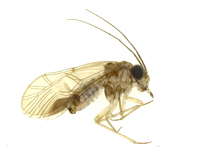Abstract
The genus Nanorana, also called Yunnan Slow Frogs (Frank & Ramus 1995), belongs to the family Dicroglossidae. Murree Hills Frog N. vicina, is an endemic species of Southeast Asian uplands in Pakistan and India and was first reported by Stoliczka (1872) from Murree, Punjab Province, Pakistan. Later Rais et al. (2014) recaptured it from its type locality and described morphology of one juvenile female and one adult male. The species is listed as Least Concern in IUCN Red List of Threatened Species while the EDGE (Evolutionarily Distinct and Globally Endangered) score is 2.64. In Pakistan, it is reported from brook water springs and streams of Murree, Galiat (North Punjab), Ayubia (Khyber Pakhtunkhwa), and parts of Azad Jammu and Kashmir (Rais et al. 2014). Although the adult form has been characterized (Khan 2006; Rais et al. 2014), the morphology of the tadpoles have not yet been described. The current study aimed to describe external morphology and morphometry of tadpoles of N. vicina.
References
Altig, R. (2007) A primer for the morphology of anuran tadpoles. Herpetological Conservation Biology, 2, 71–74.
Ampai, N., Rujirawan, A., Arkajag, J., McLeod, D.S. & Aowphol, A. (2015) Description of the tadpoles of two endemic frogs: the Phu Luang cascade frog Odorrana aureola (Anura: Ranidae) and the Isan big-headed frog Limnonectes isanensis (Anura: Dicroglossidae) from northeastern Thailand. Zootaxa, 3981 (4), 508–520.
https://doi.org/10.11646/zootaxa.3981.4.3
Chuaynkern, C., Kaewtongkum, N., Ohler, A., Duengkae, P., Duangjai, S., Makchai, S. & Chuaynkern, Y. (2018) First description of the Nanorana (Chaparana) aenea (Smith, 1922) tadpole from northern Thailand and additional information on the Quasipaa (Eripaa) fasciculispina (Inger, 1970) tadpole buccopharyngeal anatomy. Alytes, 36, 93–108.
Fei, L., Ye, C. & Jiang, J. (2012) Colored atlas of Chinese amphibians and their distributions. Sichuan Publishing Group, Chengdu, 620 pp.
Frank, N. & Ramus, E. (1995) Complete guide to scientific and common names of amphibians and reptiles of the world. N. G. Publishing Inc., Pottsville, Pennsylvania, USA.
Gosner, K.L. (1960) A simplified table for staging anuran embryos and larvae with notes on identification. Herpetologica, 16, 183–190.
Inthara, C., Lauhachinda, V., Nabhitabhata, J., Chuaynkern, Y. & Kumtong, P. (2005) Mouth part structures and distribution of some tadpoles from Thailand. The Thailand Natural History Museum Journal, 1, 55–78.
Khan, M.S. (1982) Key for the identification of amphibian tadpoles from the plains of Pakistan. Pakistan Journal of Zoology, 14, 133–145.
Khan, M.S. (2006) Amphibians and reptiles of Pakistan. Krieger Publishing Company, Malabar, Florida, 311 pp.
Khan, M.S. & Mufti, S.A. (1994) Oral disc morphology of amphibian tadpole and its functional correlates. Pakistan Journal of Zoology, 26, 25–30.
McDiarmid, R.W. & Altig, R. (1999) Tadpoles: The biology of anuran larvae. The University of Chicago Press, Chicago, Illinois, 444 pp.
Orton, G.L. (1953) The systematics of vertebrate larvae. Systematic Zoology, 2, 63–75.
https://doi.org/10.2307/2411661
Rais, M., Abbassi, S., Batool, T., Jilani, M.J., Assadi, M.A., Mubarak, H. & Baloch, S. (2014) A note on recapture of Nanorana vicina (Anura: Amphibia) from Murree, Pakistan. Journal of Animal and Plant Sciences, 24, 455–458.
Stoliczka, F. (1872) Notes on some new species of Reptilia and Amphibia, collected by Dr. W. Waagen in North-Western Punjab. Proceedings of the Asiatic Society of Bengal, 1872, 124–131.

